The Transitional 8 Reales of Philip V Struck at the Mexico City Mint 1732-1734
by Kent Ponterio
The Mexico City Mint underwent dramatic changes during the early 1730s. The introduction of new minting equipment and gradual phasing out of older coining methods resulted in a transitional period, producing numerous different coinage types and varieties. The numismatic findings recovered from the Dutch East Indiaman "Rooswijk" are largely focused on this area and offer a rare opportunity for Mexican numismatists to better study and understand the coinage of this period. With the uncovering of hoards and shipwreck finds, new discoveries are often made helping numismatists grasp a better understanding of coins and how they were produced.
In 1536 the Mexico City Mint became the first mint to produce coins in the New World. Initially the mint used the method of hammering coins by hand. This method remained in use until it was eventually phased out by the screw press some time in the year 1733. A royal decree was issued on 9 June 1728 authorizing the Mexico City mint to strike new milled coinageA. F. Pradeau, Numismatic History of Mexico from the Pre-Colombian epoch to 1823, Los Angeles, 1938, p.53. This set in motion a series of events that would drastically change and modernize the mint.
1. Patterns for the new milled coinage or "Pillar Dollar" as they are often called dated 1729 were struck at the Madrid Mint in Spain. An example of one such specimen can be seen in the introduction to Frank Gilboy's The Milled Columnarios of Central and South AmericaFrank F. Gilboy, The Milled Columnarios of Central and South America., Canada 1999. These were shipped to the New World mints as samples of the new coinage type. One such example is housed in the Mexico City Mint Museum's collection.
2. New minting equipment was imported from Spain, in effect mechanizing the mint with state-of-the-art machinery.
• Screw presses to more efficiently strike coins .
• Mule-powered roller presses for flattening silver into sheets used in the production of coin planchets.
• Cylindrical punches for the cutting of planchets from sheets of metal.
• Edge milling machinery enabling coins to be produced with anornamented edge, protecting it from clipping and counterfeiting
After the arrival of the new equipment the first milled coins or "Pillar Dollars" were struck on 29 March 1732Pradeau, op. cit. p.53. Prior to this date the mint used the method of hammering coins by hand, known as "cobs". Although the origin of the term "cob" is uncertain, it is most likely an abbreviation that derives from the Spanish term "cabo de barra," meaning end of the bar. A name adopted due to the planchets method of manufacture, cobs were hand struck on crude planchets that were cut from the end of a silver bar. During 1732, production continued for "Cobs" and commenced for the first "Milled" coinage.
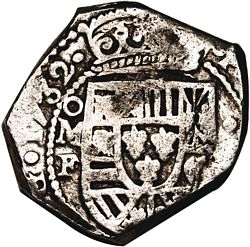
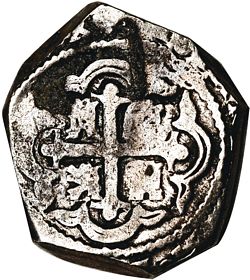
KM-47a; Cal-764; Calb-732 1732 8 Reales Mo F cob (Stack’s Bowers Baltimore auction, June 2014, lot 6238)
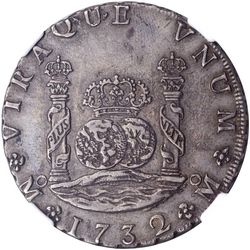
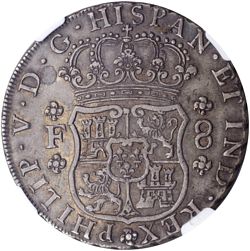
KM-103 8 Reales 1732 Mo F milled (Stack’s Bowers ANA Auction, 20 August 2021, lot 41138)
1733 8 Reales
In the following year, 1733 the mint produced more different types and varieties of 8 Reales than in any other single year. Four major different types of 8 Reales were produced: Cobs, Cobs struck with "Klippe" dies, Klippes and the Milled "Pillar Dollars". Of the four major types there are multiple varieties for each type, most of which are listed below. This year marks the end of the "Cob" coinage as its fmal year of production.
8 Reales 1733 Cob
• 1733/2 Mo F
• 1733 Mo F
8 Reales 1733 Cob struck with Klippe Dies
• 1733 Mo F Coin Die Axis
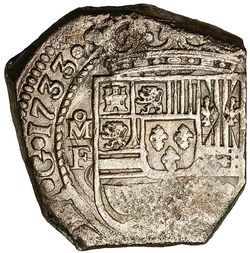
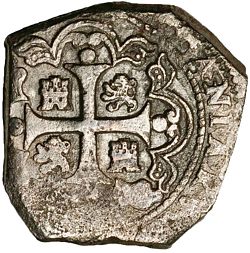
KM 48 8 reales 1733 Mo F klippe on cob (Stack’s Bowers NYINC Auction, 7 January 2011, lot 21)
• 1733 Mo F Medallic Die Axis
• 1733 Mo MF Medallic Die Axis
• 1733 Mo MF Medaliic Die Axis, Dot below denomination
8 Reales 1733 Klippe
• 1733 Mo MF Coin Die Axis
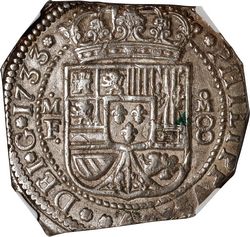
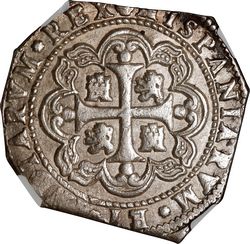
KM 48 8r klippe 1733 Mo MF (Stack’s Bowers NYINC Auction, 13 January 2023, lot 21148)
• 1733 Mo MF Medallic Die Axis
• 1733 Mo MF Medallic Die Axis, Dot below denomination
8 Reales 1733 Milled
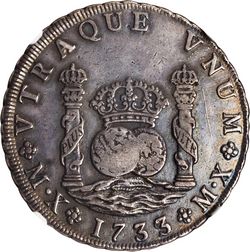
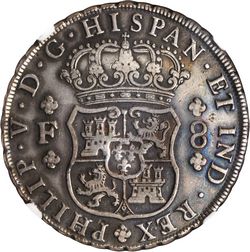
KM-103 8 reales1733/2 MX F (Stack’s Bowers Baltimore Winter 2014 Auction, lot 481)
• 1733/2 MX F
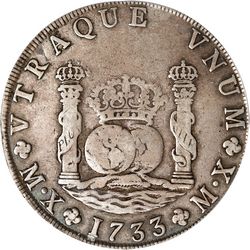
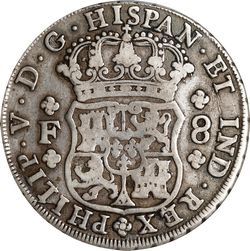
KM 103 8r 1733 MX F (Stack’s Bowers NYINC auction, 13 January 2023, lot 21150)
• 1733 MX F Small Crown
• 1733 MX F Large Crown
• 1733 MX MF Dot above assayer's letters
• 1733 MX MF Without dot above assayer's letters
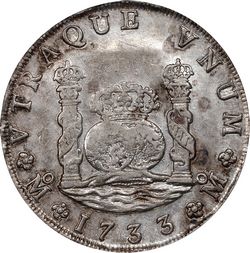
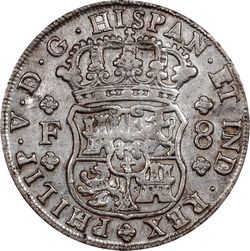
KM 103 8r 1733 Mo F (Stack’s Bowers NYINC auction, 13 January 2023, lot 21149)
• 1733 Mo F
• 1733 Mo MF Small Crown, Dot above assayer's letters
• 1733 Mo MF Small Crown, Without dot above assayer's letters
• 1733 Mo MF Large Crown
1734 8 Reales
There were two major types of 8 Reales struck in 1734, Klippes and Milled "Pillar Dollars". This year marks the second and final year of the "Klippe" coinage. Clearly they were only struck for a portion of the year until they were completely phased out by the Milled "Pillar Dollar". The majority of 1734 "Klippes" were struck from recut dies of the previous year 1733. This would indicate a smaller number of dies were manufactured with the intent to strike coins. The 1734 Milled "Pillar Dollar" remains fairly common in comparison to the "Klippe". This reflects the fact that the striking of "Klippe" coinage was temporary until Milled "Pillar Dollar" production was successfully in full effect.
8 Reales 1734 Klippe
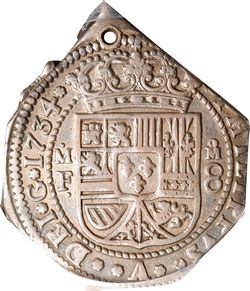
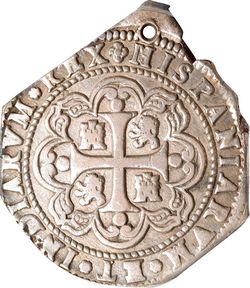
KM 48 8 reales 1734/3 Mo MF (Stack’s Bowers Auction, 26 August 2022, lot 34151)
• 1734/3 Mo MF
• 1734 Mo MF
8 Reales 1734 Milled
• 1734/3 Mo MF
• 1734 Mo MF
The exact reason the mint produced Cobs, Klippes and Milled coinage between 1732 and 1734 seems to be unknown. It's probable that the mint encountered multiple problems that played a large role in this strange occurrence. In a 1987 ANA lecture, Clyde HubbardClyde Hubbard, 8 Reales of the Mexico City Mint 1730-1734, American Numismatic Association Numismatic Theatre, Atlanta, Georgia, 28 August 1987 cited an original 18th century mint manuscript[text needed] reporting that three new screw presses, along with other equipment in route from Spain to Veracruz, Mexico were lost when the ship carrying them sank off the coast of Little Cayman Island. The lack of essential equipment, combined with the time needed to properly train personnel on new minting machinery resulted in the production of several new and fascinating transitional issues during this period. By contemporary standards, both state-of-the-art and antiquated minting machinery were in operation simultaneously. This resulted in the production of several new coinage types unique to this period of Mexican numismatics. In 1734 the mint discontinued the production of the short-lived Klippes and converted solely to the striking of milled "Pillar Dollars".
